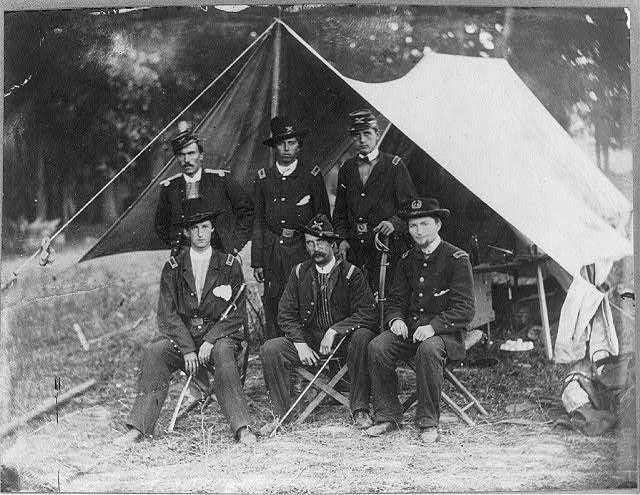The 4th U.S. Air Defense Regiment

On March 2, 1821, Congress passed legislation to dissolve the United States Army’s Corps of Artillery. In its place, four regiments of artillery were authorized for service. This organization of individual regiments had existed during America’s second struggle with Great Britain, the War of 1812. The artillerists had distinguished themselves at such battles as Chippawa, Fort McHenry, and New Orleans. Nearly three months later, the Fourth Regiment of Artillery was officially organized with its companies stationed along the Florida and Gulf Coasts.
Among the officers to serve in the regiment were John Gibbon and Stephen D. Lee. The author of an artillery manual and first commander of the famed Iron Brigade, Gibbon ended the war at the head of the 24th Corps in the Army of the James. Lee was the youngest officer to be appointed a Lieutenant General in the Confederacy and, like Gibbon, commanded a corps during the Civil War.

At the opening of the Second Seminole War, seven companies of the regiment were sent to Fort Mitchell, Alabama, and by the fall of 1836 were campaigning in Florida. Through the course of the next three years, various companies were engaged at Fort Drane, Wahoo Swamp, Ahapopka Lake, Lake Okechobee, and Tuscawilla Pond.
As conflict loomed with Mexico in the fall of 1845, four companies were dispatched to Corpus Christi. In preparation for taking the field, three of these companies were issued muskets. By the end of 1846, eight companies carried muskets and were employed both as infantry and artillery. Assigned to General Zachary Taylor’s command, the artillerists fought at Palo Alto and Resaca de la Palma before they were joined by the rest of the regiment. At Monterey, one of the regiment’s battalions participated in the storming of the enemy positions at Federacion Hill, Independencia Hill, and the Bishop’s Palace. The following February at Battle of Buena Vista, against overwhelming odds, enemy infantry captured guns from Lt. John P.J. O’Brien’s Company B.
Transferred to General Winfield Scott’s army, the Fourth participated in the Mexico City Campaign. The regiment fought at Vera Cruz, Cerro Gordo, and Molino Del Rey. During the Battle of Contreras, the regiment once again assumed the role of infantry and launched a successful assault on an enemy position. During the attack, Company G recaptured the pieces lost by O’Brien at Buena Vista. Fourth Artillerists, including Daniel Harvey Hill and Fitz-John Porter made up the assault column on Chapultepec and the Mexican capital. Among the officers who participated in the attack were Daniel Harvey Hill and Fitz-John Porter. A brother-in-law to future Confederate general Thomas J. “Stonewall” Jackson, Hill commanded a division in the Army of Northern Virginia and later a corps in the Army of Tennessee. Porter led the 5th Corps in the Army of the Potomac throughout the spring and summer of 1862.

At the conclusion of the Mexican War, the regiment’s companies were assigned to posts throughout the country. Battery G fought at the Battle of Blue Water Creek against the Sioux Indians and engaged in the growing conflict between pro and anti-slavery factions in Kansas. The entire regiment was reunited for service in Florida against the Seminoles in the latter part of 1856. In 1860, Battery B, acting as cavalry, accompanied westward bound emigrant trains and fought at the Battle of Egan Canyon.
Following the outbreak of the Civil War, batteries from the 4th U.S. were assigned to both theaters.
On July 3, 1863, under the command of Lt. Alonzo Cushing, Battery A defended the center of the Union line on Cemetery Ridge at Gettysburg and assisted in the repulse of the Pickett-Pettigrew-Trimble Charge. Cushing was killed in the battle and was posthumously awarded a Medal of Honor. Battery E was heavily engaged at Port Republic and South Mountain. Assigned to the horse artillery in April 1863 under Lt. Samuel Elder, the battery fought on Richard Cunningham’s farm at Brandy Station. As part of Maj. Gen. Nathaniel Banks’ corps, Battery F fought at Cedar Mountain during the Second Manassas Campaign.

Combined Batteries H/M fought at Shiloh, Corinth, and Stones River. In early 1863, the batteries were divided to act independently. Battery M was engaged at Franklin in November 1864. Through the efforts of the American Battlefield Trust, over 7,700 acres of these battlefields are preserved.
In the postbellum years, the batteries resumed their postings out West and in Alaska. Acting as both cavalry and infantry, elements of six batteries fought in the Modoc War. In the conflict with the Nez Percé, elements fought at the Clearwater River and Canyon Creek. In the summer of 1878, the regiment participated in a campaign against the Bannock Indians.
Shortly after the turn of the twentieth century, in February 1901, the 4th U.S. was disbanded, and its batteries reorganized within the Army’s Artillery Corps. The regiment was reconstituted in July 1924 as the 4th Coast Artillery. During World War II, the artillerists served in the American Theater, Tunisia, Sicily, and Italy as well as on Leyte and the Ryukus Islands in the Pacific. While serving in Vietnam, the unit received a Presidential Unit Citation, the highest combat award for a unit authorized by the Army for its actions in 1967. The unit participated in the Defense of Saudi Arabia and the Liberation of Kuwait in the first Gulf War and deployed to Iraq in support of Operation Iraqi Freedom. Today, the 3rd Battalion of the 4th Air Defense Artillery, traces its lineage back to Company C, of the original 4th U.S. Artillery.


